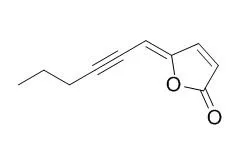| In vitro: |
| Journal of Agricultural and Food Chemistry, 2012, 60(23):5893-5898. | | Bioassay-Directed Isolation and Identification of Phytotoxic and Fungitoxic Acetylenes from Conyza canadensis.[Reference: WebLink] | Conyza canadensis (L.) Cronquist syn. (horseweed) is a problematic and invasive weed with reported allelopathic properties.
METHODS AND RESULTS:
To identify the phytotoxic constituents of the aerial parts, a systematic bioactivity-guided fractionation of the dichloromethane extract was performed. Three active enyne derivatives, (2Z,8Z)-matricaria acid methyl ester, (4Z,8Z)-matricaria lactone, and 4(Z)-Lachnophyllum lactone, were identified. The lactones inhibited growth of the monocot Agrostis stolonifera (bentgrass) and the dicot Lactuca sativa (lettuce) at 1 mg mL(-1), while the (2Z,8Z)-matricaria acid methyl ester was less active. In a dose-response screening of the lactones for growth inhibitory activity against Lemna paucicostata ,4(Z)-Lachnophyllum lactone was the most active with an IC(50) of 104 μM, while the (4Z,8Z)-matricaria lactone was less active (IC(50) of 220 μM). In a fungal direct bioautography assay, the two lactones at 10 and 100 μg/spot inhibited growth of the plant pathogenic fungi Colletotrichum acutatum , Colletotrichum fragariae , and Colletotrichum gloeosporioides .
CONCLUSIONS:
In a dose-response screening of the lactones against six different plant pathogenic fungi, (4Z,8Z)-matricaria lactone was more active than the commercial fungicide azoxystrobin on Col. acutatum , Col. fragariae , and Col. gloeosporioides at 30 μM and about as active as the commercial fungicide captan against Col. gloeosporioides , while 4(Z)-Lachnophyllum lactone was less active. |
|






 Cell. 2018 Jan 11;172(1-2):249-261.e12. doi: 10.1016/j.cell.2017.12.019.IF=36.216(2019)
Cell. 2018 Jan 11;172(1-2):249-261.e12. doi: 10.1016/j.cell.2017.12.019.IF=36.216(2019) Cell Metab. 2020 Mar 3;31(3):534-548.e5. doi: 10.1016/j.cmet.2020.01.002.IF=22.415(2019)
Cell Metab. 2020 Mar 3;31(3):534-548.e5. doi: 10.1016/j.cmet.2020.01.002.IF=22.415(2019) Mol Cell. 2017 Nov 16;68(4):673-685.e6. doi: 10.1016/j.molcel.2017.10.022.IF=14.548(2019)
Mol Cell. 2017 Nov 16;68(4):673-685.e6. doi: 10.1016/j.molcel.2017.10.022.IF=14.548(2019)